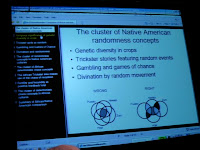
Note: This post wanders, as do many of my posts. It's not because I'm being lazy, though I could spend several more days revising and rewriting this. But blogging isn't academic research. On the other hand, I don't think I should be blogging just off the top of my head without thinking. I'm hoping - but not holding my breath - that my readers may see something that causes them to think a little differently than they did before. But when I write I also learn new things and see things a little differently. So I'm trying to avoid instant posts that reflect nothing but my own biases. The intent here is to look at things and try out new interpretations, not to vent.
That said, this is written in a larger context about the role of large oil companies in the world that I have written about previously. While on the surface, oil companies project an image of responsible corporate citizens, they are rich, powerful players on the world stage who are well dressed and polite when possible, but also in their pursuit of oil are willing to
make deals with leaders of countries like Burma and the Congo, leaders who brutally mistreat their populations. In Alaska, all this goes on much more genteelly, but goes on never the less. Some background to my thoughts on all this can be found in the following posts:
Economic Hitman and
Responding to Trip1050. Trip1050 works for an oil company and commented on my posts on the AGIA forums. He asks why I mistrust oil companies. So, if you are offended by my skepticism about oil companies, read why I feel that way before commenting.
These posts often wander, because I don't think things can be compartmentalized into neat little soundbites. Well, yes, they can. But those are not accurate reflections of the world. They are attempts to neaten the world into pieces we can understand, but aren't usually accurate. So, when I write, I try to capture how my mind wandered into various areas, I try to capture at least a taste of the messiness of reality, and allow the reader to see that nothing is black and white. While I strive to understand why things happen, understanding why someone does something, doesn't mean excusing it. But understanding why may help devise better ways to prevent others from repeating those things. Ultimately, I'm hoping that I and my readers can step back a bit from whatever the topic is, so they can see it in the bigger view, the view we don't get when we are right in the middle of it.
OK, so here's the post:
The
Anchorage Daily News has been carrying large ads from ConocoPhillips touting their employees who volunteer in the community.
"Not Your Typical Volunteer" the ads proclaim.
When help is needed, ConocoPhillips employees don't just get their feet wet - they dive in. That's not your typical volunteering and Peter Brakora isn't a typical volunteer.
So, non-ConocoPhillips employees don't dive in? I've seen volunteers at a lot of non-profits who give of their hearts to help out. At Covenant House, for example, I've seen Mentors (people working full time and with families) come to monthly mentor meetings, plus they meet with the young adults they are mentoring a couple times a month, plus phone calls. This isn't just getting their feet wet, this IS diving all the way in.
So yesterday I called ConocoPhillips to find out what makes their employees so much better than other employees. (Wait, you're saying, it says "not typical" it doesn't say "better". OK, so not typical means, what? Different? Different how? The only clue is that "they don't just get their feet wet, they dive in." To me that is saying they do more, they get more involved, they're better. Come on, why would they
spend tens of thousands of dollars (they've posted a number of these ads over the last month) to say their employees are just different? They wouldn't. They are saying their employees are better.) First I asked to be connected to the Human Resources Department assuming they would be running employee volunteer programs. That got me to a recording that told me to apply on line. So I called back. The receptionist wasn't sure who to send me to, but settled on Sandy Tusano, who didn't know, but was very nice and tried to forward me to Sheri Jones, who wasn't in, so Sandy sent me to Gina Luckey, where I left a message. (I'm not sure about my spelling of Sheri Jones. When I tried to Google her, I did find a Sherry Jones who once worked with Bill Moyers on an exposé on chemical companies. But this is a common name and I doubt it's the same person.)
In the meantime I went to the ConocoPhillips site to see if I could come up with answers about what makes them special (not typical.)
Headquartered in Houston, Texas, the company has approximately 33,600 employees worldwide [from Conoco-Phillips Website]
In 2006, the company matched nearly 3,500 employee gifts for a combined total of $6.1 million.[from Conoco-Phillips Website]
So, I started calculating. This would mean that just over 10% of all ConocoPhillips employees participated in this program. Those who participated gave an average of $1743. ($6,100,000/3500 = $1743) What does that mean? Is it a lot? A little? It depends, in part, on how much ConocoPhillips employees get paid. Checking the internet, there are various sites giving us a peek into CP salaries. Payscale.com has salaries that presumably CP employees posted. Theirs is a small sample, and not necessarily all people who posted salaries were actually CP employees or posted their correct salaries. I would guess that people checking out salaries are those earning less than average, but that's just a guess. We also don't know if this is a representative set of salaries or if it skews high or low. But I think this at least gets us in the ballpark. (This is an example of my rambling, because I'm not just giving you a number, but I'm telling you how I got it, and why I'm using it, and raising questions so you can evaluate its validity on your own.)
[You can double click the images to enlarge them.]

I'm also going to assume that people tend to stay at CP if they can, so I'm going to take the 10-19 year median salary of $87,973. A person earning $87,973 contributing $1,743 is contributing just under 2% of her salary. (The regs allow them to contribute up to $6000.)[Or so I thought when I read the website yesterday. This turns out to be related to volunteer time. More on that later.]
Or we can put this into context another way. Here's a list of the top eight executive salaries at CP Worldwide (filed 4/2/2008): (Again, double click to enlarge the chart.)

These eight employees out of a total of about 33,000 employees of CP earned $109,440,405. That's $109 million. (That's eight people making the same amount of money as 1,224 employees making the guestimated 10-19 year employee median of $87,973.)
The $6.1 in matching contributions that CP makes for ALL its worldwide employees is equal to 5.5% of the income of the top eight employees of ConocoPhillips!

But I really wanted to hear from ConocoPhillips about what makes their employees such atypical volunteers. So I called Gina Luckey again. She said she'd sent the message over to her supervisor Natalie Lowman, Director of Media, so I called her and left a message. (The CP website lists her as Director of Communications.) She called back not long ago.
She helped clarify some things. First, ConocoPhillips does NOT match cash contributions, they give grants up to $1500 to organizations that CP employees volunteer with for a certain minimum number of hours. I looked back at the website and it does say grants for volunteering on one page, but the other page that said "...
the company matched nearly 3,500 employee gifts for a combined total of $6.1 million" does make it sound like contributions in money rather than time.As I look back now while writing this, that $1500 figure doesn't gibe with the average I figured based on the CP Worldwide website figure of $6.1 million for 3500 employees, which came to $1743 per employee. That
page of the website says
By volunteering their time, employees in the United States enable organizations to receive up to $6,000 in grants per year from ConocoPhillips to defray costs for programs and events, making a positive and important difference in their communities.
Natalie Lowman wasn't exactly sure how much CP gave in such grants in Anchorage, but thought it was around $60,000 for 2008. They could give up to $1500 per employee. When I pointed out that the website said up to $6,000, she said, yes, if there were four employees at one organiztion.
Answers.com says ConocoPhillips Alaska, Inc has 900 employees. At $1500 per employee, that would make a total of 40 CP employees volunteering. If they didn't give the full $1500 per employee, say they only gave half of that - $750 - on average, that would be 80 employees out of 900. So we could guestimate that somewhere between 4.5% - 9% of CP Alaska employees volunteered enough to trigger a grant. Or maybe they did volunteer work but didn't apply for a grant. Or more than four people worked for the same non-profit.
I hadn't done that local calculation when I talked to Lowman, but I did mention that worldwide, given the number of employees listed on the website cited above, that it came out to less than 10% of the employees. That's when she cleared up my misconception that CP matched cash contributions. She said that most employees were really busy, like she is, and so they would rather make a monetary contribution than a volunteer contribution. But, she clarified further, the company does NOT match monetary contributions. She also said that most CP employees contribute through United Way. She said if one in ten volunteered, probably six or seven others made monetary contributions.
I also know that CP makes other contributions to the community such as
$100,000 to the Museum in 2007. And there was a $3.68 million gift to the University of Alaska also in 2007. But we need to put an * on that. The
University of Alaska press release on the gift also says,
The annual gifts stem from a charter agreement between the oil companies and the state regarding the BP merger with ARCO in the late 1990s. Part of the charter agreement identifies public higher education as a top priority for charitable donations.
So, these donations are part of an agreement negotiated so that BP could merge with ARCO in 1999. The Foraker Group Nonprofit Report December 2006 written by the Institute of Social and Economic Research (ISER), University of Alaska Anchorage (pp. 43-44) gives a bit more information on this charter agreement:
In 2006 two of the largest oil companies operating in the state, BP (BP Exploration Alaska, Inc.) and ConocoPhillips contributed a combined total of over $22 million in cash to various Alaska nonprofits, including the University of Alaska, and other organizations such as local governments. Their annual contribution is based upon oil production and price as defined by a Charter Agreement that resulted from the ARCO BP merger in 1999. Some in-kind donations are not included in this total, and some of their donations fund capital expenditures rather than operations.
So a minimum amount of contribution is required by this Charter Agreement that was a condition for the BP-ARCO merger. I called Scott Goldsmith, the author of the ISER report, to find out how to get access to the Charter Agreement.He wasn't sure if he ever actually saw a copy, but said he'd check for it tomorrow. [Update: I also called UAA Advancement and later the UA Foundation called and said they would find the Agreement and email it to me .] On the internet, nearly all references I find about BP or ConocoPhillips contributions to the University have that standard clause in them.
I also asked Lowman how ConocoPhillips encourages their employees to volunteer. She said that there's paid time off for clean up day and that employees on Boards can go to board meetings on company time because the company wants them to be involved in the community. I think she said there was additional paid time off allowed for volunteering, but I'm not sure.
So, where's this all going? I initially took exception to the idea that ConocoPhillips employees are somehow better than the typical volunteer. Lowman, when I raised that point, said that wasn't what was intended at all. They were just trying to salute their employees who volunteer and they support all volunteers from any organization. I believe that was their intent.
But was "Not your typical volunteer" simply to mean that they are different? "They don't just get their feet wet, they dive in" implies, to me anyway, that typical volunteers just get their feet wet, but do not dive in.
Well, I guess we could say they aren't typical because they are actually getting their regular salary for some of their volunteer work, not like typical volunteers who volunteer on their own time. I don't say this to belittle the ConocoPhillips volunteers, who, I'm sure, spend more hours volunteering than they are reimbursed for. But it does make them atypical. There's a bit less sacrifice if you're being paid your regular salary to volunteer.
Perhaps the ads should say that ConocoPhillips is not your typical employer, because they pay their employees to volunteer. But then some other employers match their employees' financial contributions.
I think we also have to address the question of why corporations give to charity in the first place.
Many economists argue that the purpose of corporations is to make a profit, that any extra money should be given to shareholders, not to charity.
GMR, a blogger whose profile describes him as a Republican MBA in Finance who works for a private equity firm summarizes what many feel about corporate giving:
There are a few times when I think a corporation should give to charity. The first is if it's not really charity: on the surface, it looks like charity, but so much good will is generated, that it's a win-win...
The second type of charity that I'd support is if a corporation were trying to reverse an earlier wrong. Even without the PR benefit. (For instance, if a record company distributed a CD that advocated cop killing, which is within the first amendment rights, but then someone followed the advice. The corporation may not have acted illegally, but it certainly didn't act responsibly).
Finally, I'd support general charity to whatever organization if the board truly believed that the shareholders wanted to give to these charities.
Linda Sugin argues in a long article that the tax law should be changed so that charitable deductions are considered business expenses:
In fact, there is significant evidence that corporations generally make charitable donations in furtherance of their business--either with respect to their employees, customers, or the communities in which they operate. Most corporate charitable giving can easily fit within the requirements of section 162's deduction for ordinary and necessary business expenses. (p. 8)
Corporations, she says later, shouldn't be making charitable donations that don't help the bottom line. When they do it leads to abuse:
Both the popular press and the academic literature are replete with discussion of corporate philanthropy that does more to achieve the private interests of managers than either the public interest, which is the concern of charitable organizations, or the shareholders' interest, which is the concern of corporate governance. (27) The problem seems primarily to be one related to executive compensation; corporate philanthropy that allows managers to support their favorite causes and enjoy the prestige benefits of that support is simply a managerial perquisite. (28)
The Supreme Court's interpretation of "gift" implies something given out of "detached and disinterested generosity." (45) Obviously, a corporation never does anything with feelings of generosity. (46) (p. 8)
The above quotes are from a business professor.
I think Alaskans reading these ads should keep this carefully in mind. The big oil companies used to pretty much have their way in Alaska. The merger between BP and ARCO caused some Alaskans to fight for a few concessions, including the Charter Agreement requiring a set formula for charitable giving. Then, in the wake of the FBI corruption investigations, the Legislature did not approve the privately negotiated deal between Frank Murkowski and the oil companies.
Governor Palin set up criteria for the gasline that the oil companies didn't like and they boycotted the AGIA RFP. They still have a lot of power and they don't have to agree to release the gas. They could scuttle the agreement with Trans Canada. They are working together on the so-called and trademarked "Denali Plan" as an alternative. Plus, the price of oil went over $4 last summer and now has dropped under $2.50 in Anchorage (but still much higher than in the Lower 48) which has a lot of Alaskans wondering if something fishy isn't going on.
So this is a good time to make Alaskans think that the oil companies care for Alaskans. That their employees are good community members (and I'm sure many are). But it was the Communications (PR) office who fielded my questions, not the Human Resources office which normally would be in charge of employee benefit programs. Part of me can't help but wonder whether "
it's not really charity: on the surface, it looks like charity."
But I probably wouldn't have had anything to say about this if it hadn't been for the implication that ConocoPhillips employees somehow make better volunteers. We know that oil companies put out 'feel good' ads to make the locals think the companies are good citizens, but when they do this at the implied expense of other good citizens, I just needed to say something.
 I could get black and white pictures developed in town in a day or two. But there were either 24 or 36 pictures on a roll and it could take days to weeks before I finished a roll. My color slides had to be sent to Hong Kong or Australia to be developed and that took at least two weeks before I could get my pictures back.
I could get black and white pictures developed in town in a day or two. But there were either 24 or 36 pictures on a roll and it could take days to weeks before I finished a roll. My color slides had to be sent to Hong Kong or Australia to be developed and that took at least two weeks before I could get my pictures back. The pictures are digital so you can upload them to your computer, email them, send them on your cell phone. You can enlarge them, crop them, even fiddle with the colors and exposure.
The pictures are digital so you can upload them to your computer, email them, send them on your cell phone. You can enlarge them, crop them, even fiddle with the colors and exposure. 1. What's in those boxes in the basement? Take pictures as you load them up.
1. What's in those boxes in the basement? Take pictures as you load them up. 2. There's a map on the sign, but will you remember the path when you leave the sign? Take the sign with you.
2. There's a map on the sign, but will you remember the path when you leave the sign? Take the sign with you.


 5. Keep track of the information on the for rent signs you pass and what the place looks like.
5. Keep track of the information on the for rent signs you pass and what the place looks like.


 9. Wonder what kind of flower it is? Take a picture then ask someone at a nursery.
9. Wonder what kind of flower it is? Take a picture then ask someone at a nursery. 10. How will I remember all these people I just met and their names? Sometimes you need to ask them to write it in English though too.
10. How will I remember all these people I just met and their names? Sometimes you need to ask them to write it in English though too. 12. I want a copy of this legal document, but they charge $1 a page to print - just take a picture of the computer screen. Also good for your airlines reservations or that I paid my bill on line.(You can do a screen saver too, but not if it's a public computer.)
12. I want a copy of this legal document, but they charge $1 a page to print - just take a picture of the computer screen. Also good for your airlines reservations or that I paid my bill on line.(You can do a screen saver too, but not if it's a public computer.) 13. I really like this camcorder, (jacket, necklace) but I need to check with my wife before buying it. Snap. (get the price tag too.)
13. I really like this camcorder, (jacket, necklace) but I need to check with my wife before buying it. Snap. (get the price tag too.) 14. That's a nice fence, (door, window.) Wonder if I could make/find one like that? Just so I don't forget what it looked like, snap.
14. That's a nice fence, (door, window.) Wonder if I could make/find one like that? Just so I don't forget what it looked like, snap.
 16. Lecture going too fast? Take digital notes.
16. Lecture going too fast? Take digital notes. 17. What's the license plate number of your rental car?
17. What's the license plate number of your rental car? 20. Need to have a copy of a price quote, birth certificate, or passport (or any piece of paper)? Just take a picture.
20. Need to have a copy of a price quote, birth certificate, or passport (or any piece of paper)? Just take a picture.

















